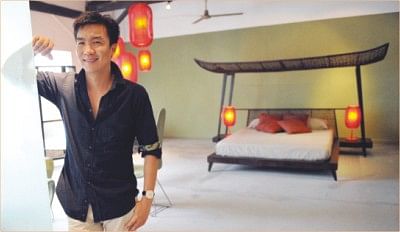Filipino furniture designer a Hollywood hit

Philippine furniture designer Kenneth Cobonpue posing for a photo at his showroom in the central Philippines city of Cebu. The multi-award-winner is regarded by international design magazines as one of the poster boys of Asia's chic furniture design industry and his unique works have penetrated the luxury market around the world.
Photo: AFP
His designs may be in Hollywood but his heart is at home: renowned Filipino furniture designer Kenneth Cobonpue says he still gets his inspiration from the sun-baked shores of Cebu.
The multi-award-winner is regarded by international design magazines as one of the poster boys of Asia's chic furniture design industry and his unique works have penetrated the luxury market around the world.
They can be found on movie sets, in the home of US movie star Brad Pitt -- who bought a Cobonpue bed -- and in leading hotels, establishments and resorts in Paris, London and the Caribbean.
Yet for all his success, the 40-year-old father-of-two remains firmly grounded to his roots.
He says his creative ideas come from nature and locally-sourced materials in Cebu, an island province in the central Philippines, famous for its colourful festivals and sweet mangos.
"In the beginning, I always looked at nature for reference -- the transparency, fluidity. These are characteristics of nature that I want to capture in the objects I design," Cobonpue told AFP at his factory in Cebu City, which is also the country's booming furniture industry capital.
"But actually, inspiration comes from everywhere. There is beauty in everything we see, if only we can take a second look."
Although Cobonpue credits his natural talent to his mother, Betty, who is a famous local designer, he sharpened his skills at New York's Pratt Institute where he studied Industrial Design in the late 1980s.
He was also apprenticed at leather workshops in Italy and in Germany until 1994, before heading to the United States in the hope of landing a job with one of the big design houses there.
However he was forced to return to the Philippines in 1996 when he could not find a spot in the tough US market.
"There was no work to be found. Even Harvard graduates were driving taxi cabs at the time," he said.
"We had a furniture factory back home, so I took over."
Once back in Cebu, Cobonpue experimented with different designs using humble rattan as the raw material. He used the skin of the vine for binding and as a weaving material, with its core forming the wooden structure.
Manufacturing under his own name, Cobonpue's meticulously hand crafted, modern designs slowly gained fame beyond Cebu and replaced the 1980s-era catalogue of his mother.
Each design portrayed a certain kind of character, or had a hidden story behind it.
The first major breakthrough was a collection called Yin and Yang -- with beds and chairs made from rattan splits over a frame of steel and wicker that combined form and function using round and square shapes.
Another critically acclaimed set was the Lolah collection, which used traditional Filipino boat building techniques in bending rattan to showcase its flexibility and create sensuous frames.
Accolades followed, including the top prize for a lounge chair at the Maison et Objet exhibition in France in 2009 as well as awards from the Hong Kong Design Centre and the Singapore International Furniture Design competitions.
Several of the designs were also picked for three editions of the authoritative International Design Yearbook, underscoring Cobonpue's status as a furniture virtuoso.
But perhaps what signalled Cobonpue's entry into the big league was the 2001 launch of his Voyage collection, cocoon shaped beds that were reminiscent of ancient reed boats.
"They aim to take the sleeper into an imaginative journey into dreamland," Cobonpue said.
The bed became famous when Pitt, an avid art collector, bought one from a showroom that represented Cobonpue designs in Los Angeles.
Orders then flooded in from Hollywood, and Cobonpue sets were used in movies, including the Ocean's 11 franchise starring George Clooney, Julia Roberts and Pitt, among others.
They are also familiar sights in the hit American television series, CSI.
"You know at first, I didn't know what to make of it. The attention we got after that was incredible," the soft-spoken Cobonpue said.
"I feel that as an artist, your work should validate itself, not because of some celebrity buying your work.

 For all latest news, follow The Daily Star's Google News channel.
For all latest news, follow The Daily Star's Google News channel. 



Comments